It’s a mild summer’s evening, but the grey sky is threatening rain. I’m bumping along a farm track in an ATV driven by James Robinson, the fifth generation of his family to farm at Strickley, a dairy farm a few miles east of Kendal. The gently rolling hills, glimpsed through thick hedges, are such a contrast to the more mountainous northern fells that are my usual stomping ground, and I’m reminded again of how wonderfully diverse Cumbria’s landscape is.
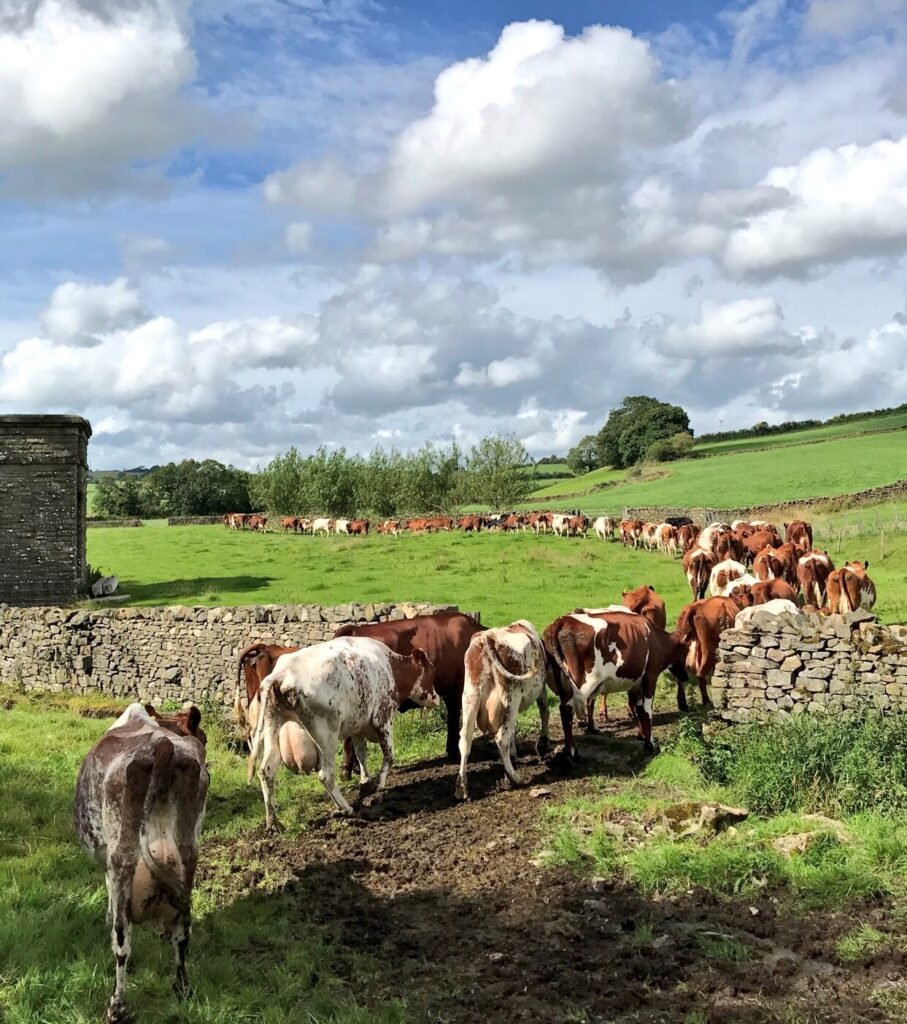
Strickley is the first dairy farm I’ve visited while writing this series. The demand for cheap food and the control of the supermarkets means that dairy farmers typically receive a price for their milk that only just covers costs of production. This has forced many to work their land extremely hard in order to make ends meet, often with negative consequences for the environment. Thanks to his expert use of social media, I’d seen that James appeared to have found a way to produce milk alongside actively caring for nature, and I’m looking forward to finding out how he does it. We’ve only got a couple of hours before the light goes, and there’s a lot to see.
The first stop on the tour is a wet area at the bottom of gently sloping field. Danny Teasdale, who heads up the Ullswater Catchment Management Community Interest Company, has been here with his digger recently. Danny has been busy in recent years creating ponds and wetlands, planting hedges and trees on farmland in the Ullswater area. His visit to Strickley was a rare foray south of Shap. Where previously there was a simple straight ditch, created decades earlier in an unsuccessful attempt to drain a marshy area now thick with rushes, Danny had dug a new wiggling channel, with a series of ponds and wetland scrapes either side, a haven for dragonflies, amphibians and wetland birds. Most farms, especially in undulating places like Cumbria, have patches of land that are too wet, too rocky or too steep to be farmed productively. James has several on his farm, so he figures that the best thing to do with them is give them over to nature, and then make them as rich and wild as possible. The new wetland with its meandering stream runs for several hundred metres along the edge of the field, connecting to other wetland areas and creating a broad, soggy natural corridor for wildlife.
The next stop on the tour is also all about connectivity. Strickley’s 7 miles of hedgerow are clearly James’s pride and joy. Thick, bushy, tall and glorious, these are without the doubt the finest hedges I’ve seen in Cumbria, and they haven’t ended up like this by accident. Every year, working alongside his father, Henry, and his son, Robert, James lays around 500m of hedge. Hedge laying is an ancient and skilful art, involving putting special cuts into the trunks of hedgerow trees to allow them to be laid almost horizontally. As long as enough of the trunk is left intact, the trees will continue to grow, and as vertical growth pushes up from the laid stems, the hedge becomes a thick, impregnable tangle, providing a barrier to livestock and the perfect habitat for nesting birds, small mammals and huge host of insects. James can measure the span of his life and of the generations that came before him in these hedges. At 500m a year, he knows it’ll take him 20 years or so to lay all the hedges on the farm. That means he’ll do them all three times in his long working life. Henry knows that it’ll be the last time he’ll do the section he helped to lay this last winter. Robert knows that he’ll do it twice more before passing the baton on again. There is something deeply moving in hearing James talk about this link he has to his land. There’s no doubt that he knows just what a privilege it is, and how careful he must be to ensure that what he passes on is better than that which he inherited.
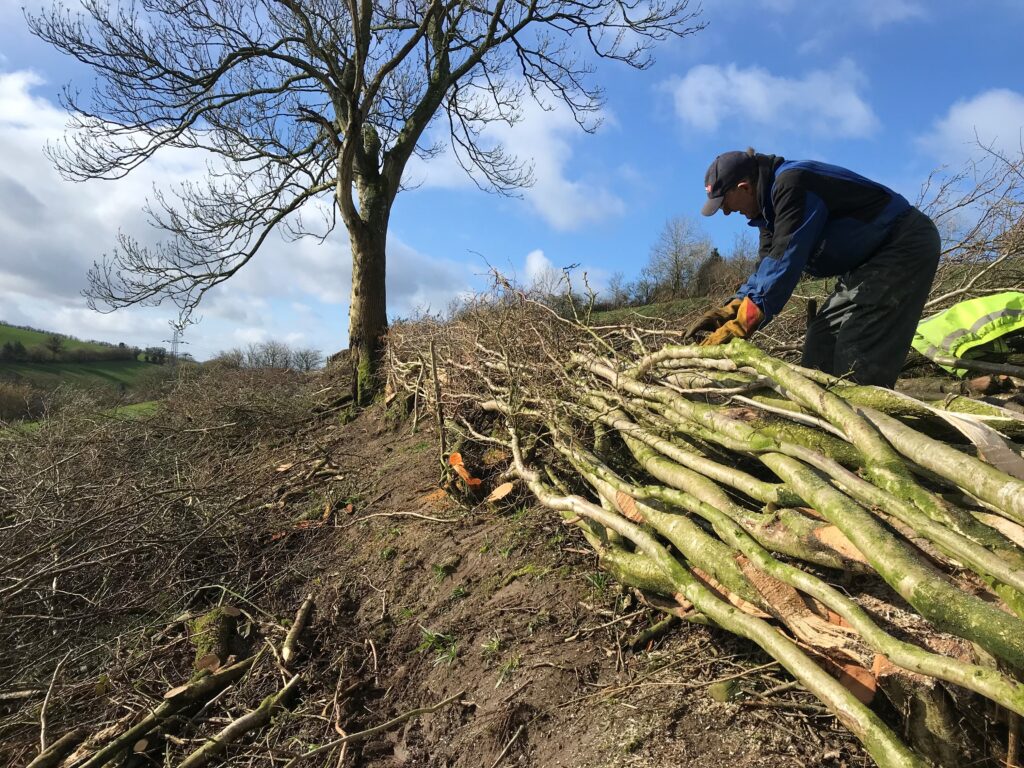
We probably could talk about hedges all evening, but the sun is getting low. Walking through a gate into a wood, James tells me how thirty years ago, seemingly on a bit of a whim, his grandfather decided he would turn one of his fields over to nature. Perhaps as he was aging, he was thinking about the legacy he would leave behind. The trees that were planted while James was starting secondary school have matured into a proper woodland with aspen, birch and oak now towering overhead.
Over the last year or so, I’ve enjoyed a bit of friendly Twitter banter with James, Danny and a handful of other farmers about who has the best ponds. We’ve created a good number on the land I look after at Haweswater, but James is convinced that his are the finest. James’s pond lies a hundred metres or so into the wood. Granted, it’s had thirty more years to develop than the ones we’ve made at Haweswater, but setting eyes on it, I concede immediately – this is a proper prize-winner. With a sizeable island, covered in scrubby willow and bramble, the pond teems with life. A pond-dipping platform used by local school groups extends over the water between lush stands of irises, meadowsweet, willowherb and club-rush, and ducks leave criss-cross swimming trails in the pondweed. James has seen otters and kingfishers here, and it’s the place he comes to unwind between milking shifts.
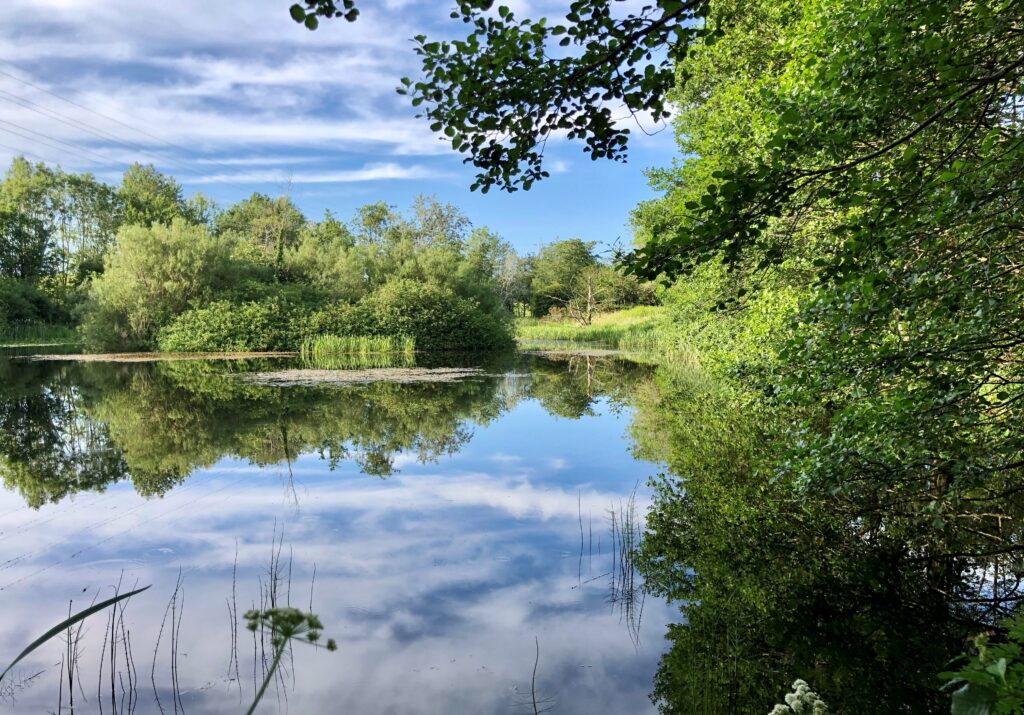
Leaving the leafy shade of woodland behind, the next stop introduces me to the farm’s superstars. James’s herd of pedigree dairy shorthorn cattle are as deeply rooted to Strickley as he is. They were one of the few fortunate herds that escaped the purges of foot & mouth, and their bloodline is unbroken for 100 years. Shorthorns are a lovely looking breed, richly patterned in crimson and white. As we chat in the failing light, a group of heifers playfully bound over to see us, leaning over a recently planted hedge, nibbling on hazel leaves and scratching against the barbed wire.
As much as James loves nature and is doing a huge amount to enhance and protect it on his farm, he accepts that there are hard decisions to make in order for him to survive as a viable farm business in the modern world. Silage fields make up the majority of the area of the farm, which are cut at least twice a year, usually three times. Strickley is an organic farm, so the fields rely on natural means to ensure they stay rich and fertile. The magic ingredient is clover which, as a legume, has the ability to pull nitrogen from the atmosphere and trap it in the soil, adding natural fertility and avoiding the need for chemical fertiliser. Bees gorge on the clover flowers, and because pesticides aren’t used – again due to the farm’s organic status – they can thrive alongside many other insects. These silage fields then are better than most conventional dairy fields as far as nature is concerned, but there are some species that they can’t support.
Each spring, curlews return from their coastal breeding grounds looking for places to raise their young. Before farming became quite so intensive, hay meadows provided the perfect place. Left to grow from early spring and not cut until late summer, they provided tranquil oases, offering both cover and insect food to the curlews and their chicks. The post-war drive for food security changed all this and farmers everywhere were encouraged to squeeze more and more produce from their land. Bigger machines, new farming methods and more animals all enabled yields to grow. Virtually all dairy farms switched from growing hay to silage, and taking more frequent and earlier cuts. The hay meadows that now remain are a tiny fraction of what there used to be – 97% have been lost since the Second World War. Across huge swathes of what were once safe breeding grounds, curlews found that there was no longer time for their chicks to develop before the tractors arrived to take the first silage cut. This, in addition to other changes to how we manage our countryside means that curlews are now one of the most rapidly declining bird species, and there’s a real chance that their haunting, bubbling call might not be heralding the spring for much longer.
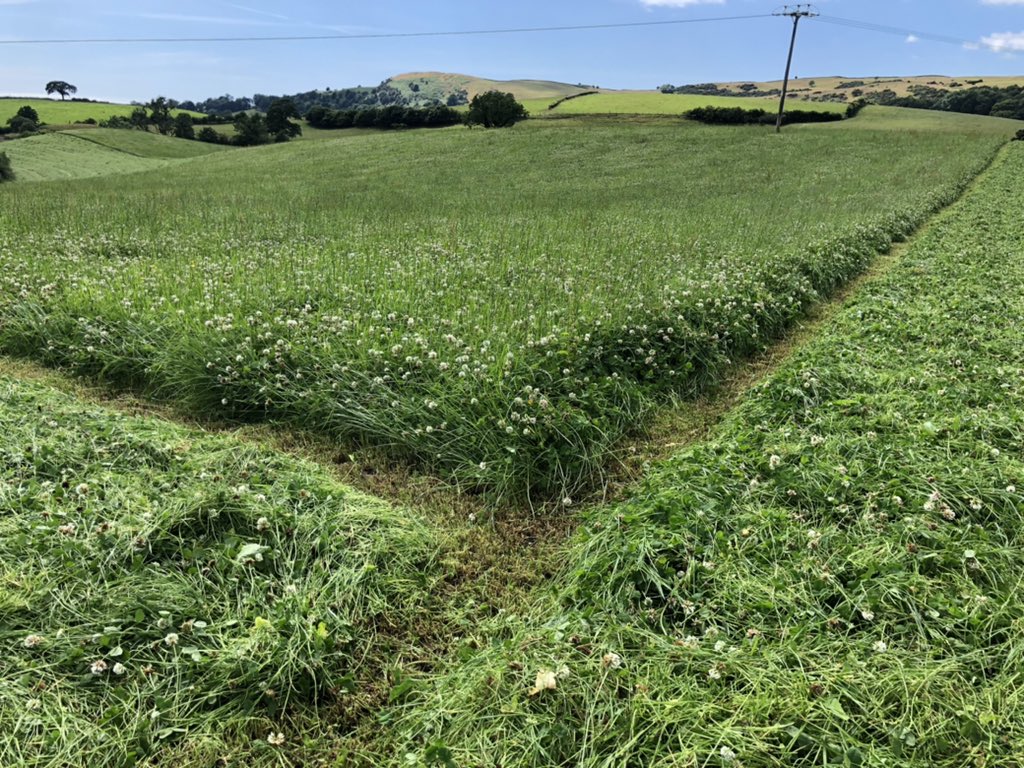
James has tried all sorts of things to help curlews on his land. For the last couple of years, friendly neighbours helped to find curlew nests in his fields so that he could cut around them. This he did, but the patch they were left in was obvious to predators, and the eggs were gobbled by crows. Curlew nests are incredibly difficult to spot, and even with an army of keen-eyed nest finders, it simply isn’t practical to locate and protect them all. So why doesn’t James just delay cutting all of his fields until the curlews are safely away? Dairy farms, even organic ones, are resource hungry beasts. James has vets to pay, diesel, tractors, buildings and milking equipment to buy and maintain. He calculates that to delay his first silage cut by long enough to give curlews a chance would cost him around £30,000, a figure that could sink his business. James genuinely cares about curlews, and it’s clear that this is a problem he’s agonising over, but like many farmers, he’s locked into a system that doesn’t allow him to do everything he’d like to. Farming with nature isn’t always easy.
Of all the farms I’ve visited so far in the course of writing this series, I found my one to Strickley the most thought-provoking. James’s deep, long connection to his farm is a powerful thing, and the decisions he makes about how to care for it are clearly influenced both by the past, and by the future. His hedges, woods, wetlands, clover-filled fields and organic status add up to real gains for nature, and it’s clear that he’s continuing to weigh up the pros and cons of whether he could do more within the confines of his farming system.
Many of the changes James has made at Strickley are not only good for the environment, they are also good for his business. Going organic has reduced his input costs by saving on the purchase of fertiliser and pesticides, while giving him a premium for his milk. His hedges, woods and wetlands help him attract government grants for nature friendly farming. James firmly believes that if more farmers received good, independent advice, more would embrace the same methods that he has. I hope he’s right.
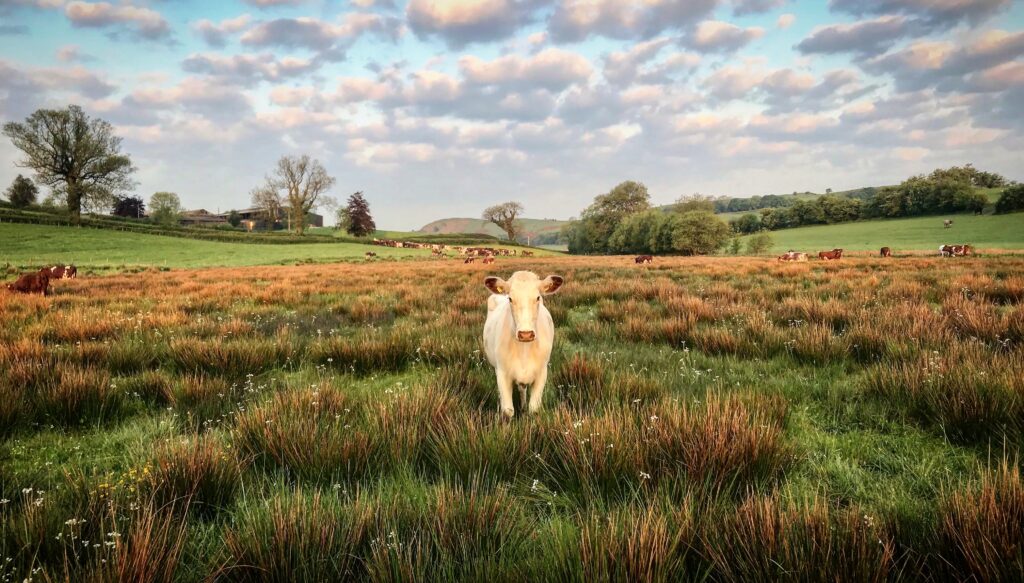
Follow James on Twitter/Instagram @JRfromStrickley or visit his website to learn about their educational visits – visitmyfarm.com